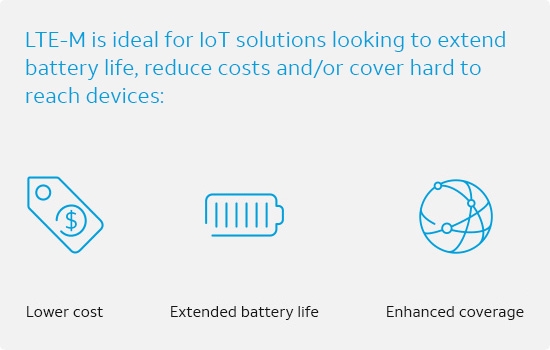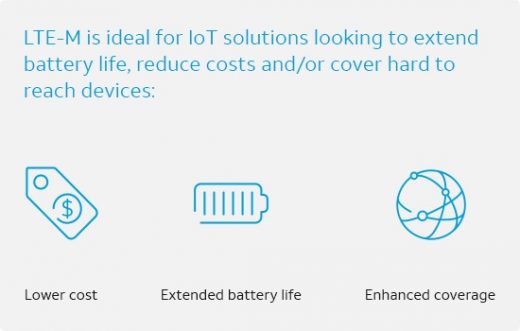Why LTE-M is a game changer for IoT
Why LTE-M is a game changer for IoT

LTE-M promises to transform the Internet of Things (IoT) by connecting more “things” in more places than ever before. We spoke with Cameron Coursey, vice president of IoT Solutions, AT&T, about what companies need to know.
What is LTE-M and why is it a game changer for IoT?
LTE-M connects IoT devices and applications directly to a 4G LTE network without a gateway. LTE-M technology is designed specifically for IoT devices and applications. It’s ideal for alarm panels, smart cities wearables, metering and more. And LTE-M provides carrier-grade security across our nationwide LTE network.
What are the benefits of LTE-M?
LTE-M is capable of providing:
- Longer battery life (expected up to 10 years).
- Better coverage for IoT devices underground and deep inside buildings.
- Smaller module size – as small as a penny.
- Lower costs – modules priced at well under $ 10
Why is selecting the right IoT network so important?
Connectivity is the first step. It’s oxygen for the IoT.
Success in the IoT marketplace depends not only on your device or app, but on choosing the right network, at the right time, in a rapidly evolving market. You need to connect to the network that best fits the specific demands of your IoT devices.
Building a successful IoT solution is all about matching your connectivity needs to the right technology or mix of technologies. Whether you choose one network technology or take a multi-network approach, you want the best blend of coverage, performance, and value.
What should businesses consider when choosing an IoT network?
I tell businesses that they should consider a number of factors:
Coverage requirements can be very different for various IoT devices. Some move frequently and need the breadth and scale of the cellular network. Others are so remote that only satellite services can effectively communicate with them. So, there are device and use aspects to be considered.
Mobility is also important – knowing whether and how your IoT devices will be mobile is essential for technology selection. Each wireless network technology has a range or distance that limits a device’s ability to communicate to network access points. Some technologies work best for fixed locations, others can support limited or low speed movements, others support full mobility.
Battery life plays an important role in the design of IoT devices. If batteries can last for months or even years on a single charge, more things can be connected in more places for longer periods of time.
Cost is a major factor in virtually every project. These include one-time hardware and deployment costs as well as recurring costs, which include network services, management platforms, cloud data storage, maintenance and logistics, and security.
AT&T stood up its LTE-M network in the U.S. earlier this year. What can you tell me about that?
In May, AT&T deployed its nationwide LTE-M network through software upgrades at existing cell sites. The LTE-M network is now live on our nationwide 4G LTE network. We plan to deploy LTE-M across our LTE network in Mexico by the end of 2017 to create the first North American LTE-M footprint.
Our nationwide LTE-M deployment marks another step forward on our path to 5G and massive IoT. We can now reach new places and connect new things at a price that’s more affordable than ever before.
How do businesses connect and develop on the AT&T LTE-M network?
The AT&T LTE-M IoT Starter Kit gives designers the tools to develop and prototype IoT devices for AT&T’s LTE-M network. The kit includes all the elements required to collect sensor data, connect to the AT&T network, and utilize various cloud services for the management, storage, and analytics of a connected IoT device.
At AT&T, we help companies of every size develop IoT solutions to lower costs, gain efficiencies, and improve competitive advantages. For more information on our complete suite of IoT solutions and services, visit us at marketplace.att.com.
The post Why LTE-M is a game changer for IoT appeared first on ReadWrite.
(40)













